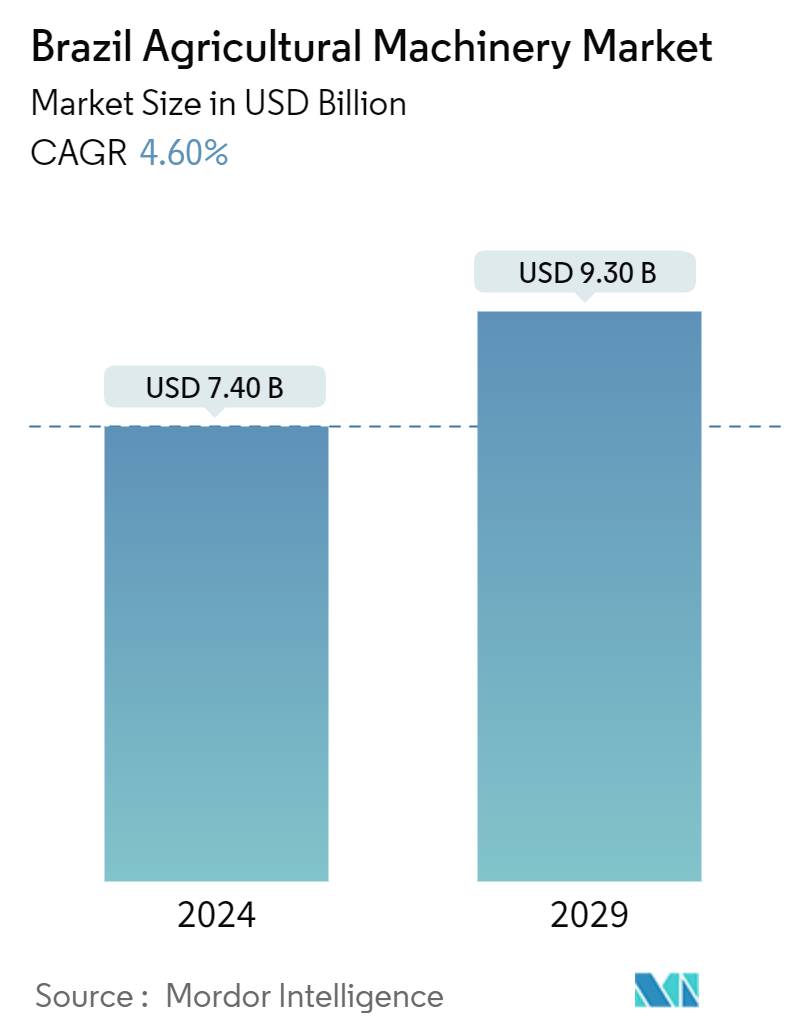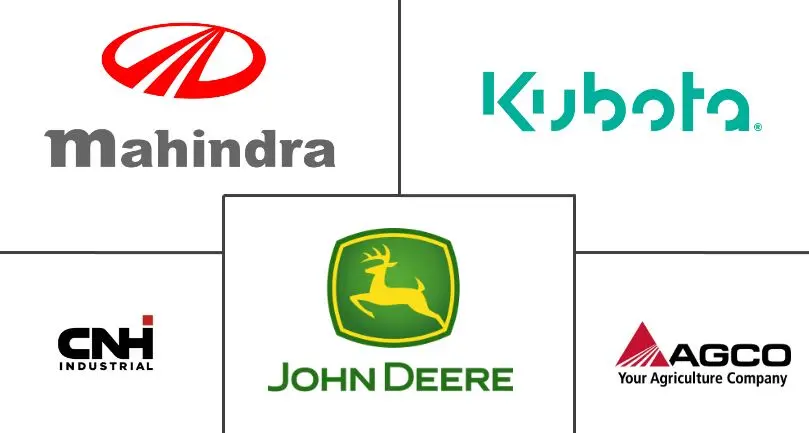Market Size of Brazil Agricultural Machinery Industry

| Study Period | 2019 - 2029 |
| Base Year For Estimation | 2023 |
| Market Size (2024) | USD 7.40 Billion |
| Market Size (2029) | USD 9.30 Billion |
| CAGR (2024 - 2029) | 4.60 % |
| Market Concentration | High |
Major Players
*Disclaimer: Major Players sorted in no particular order |
Brazil Agricultural Machinery Market Analysis
The Brazil Agricultural Machinery Market size is estimated at USD 7.40 billion in 2024, and is expected to reach USD 9.30 billion by 2029, growing at a CAGR of 4.60% during the forecast period (2024-2029).
- Agriculture in Brazil is well developed in attaining self-sufficiency, and the country is also one of the major exporters of several agricultural commodities. The government has extensive farmland and the potential to expand it on a large scale. Therefore, the increase in area around agriculture caters to the growth of the agricultural machinery market. According to the Brazilian Institute of Geography and Statistics, the planted area for cereals, vegetables, and oilseeds in Brazil increased from 73.2 million ha in 2022 to 77.5 million ha in 2023. Additionally, the increased awareness of farmers about advanced agricultural equipment to improve production, reduction of crop production costs, and income-focused tendencies are pushing them to adopt agricultural equipment on farms.
- Along with this, more prominent farm owner's acquisition of smaller farms is increasing the consolidation of farms. Larger farms require a huge amount of farm labor for farming operations. On the other hand, agricultural employment in Brazil dropped from 9.5% in 2021 to 8.7% in 2022. Therefore, to fulfill the demand, large farm owners prefer agricultural machinery, making farming operations easy and cost-effective. Moreover, the government's supportive initiatives are also contributing to market growth. In 2023, the Minister of Agriculture and Livestock launched the country’s 2023-2024 Crop Plan and allocated USD 72.9 billion to support national agricultural production. This plan also reduces interest rates for acquiring agricultural machinery and equipment through the Program for Modernization of the Fleet of Agricultural Tractors and Associated Implements and Harvesters, which further supports market growth.
- The market is primarily dominated by players such as John Deere, AGCO, and CNH Industrial due to the higher quality of products and better after-sales service. The strategies adopted by the players are fueling the growth of agricultural equipment in the country. For instance, Valtra, an AGCO brand, a global leader in the design, manufacture, and distribution of precision agricultural machinery and technologies, launched Valtra's first FarmerCore satellite store in Brazil. The FarmerCore strategy aims to bring together and transform the way rural producers and dealerships interact and benefit from the services and products offered by the brand. Therefore, the expanding planted areas, favorable government initiatives, and strategic activities by the major players are expected to drive market growth during the forecast period.
Brazil Agricultural Machinery Industry Segmentation
Machines used for agricultural activities, such as planting, seeding, fertilizing, pest control, irrigation, harvesting, and haymaking, and post-harvest activities, including loading, unloading, and storage, are considered agricultural machinery.
The Brazilian agricultural machinery market is segmented by tractor (below 80 HP, 81 to 130 HP, and above 130 HP), ploughing and cultivating machinery (ploughs, harrows, cultivators and tillers, and other ploughing and cultivating machinery), planting machinery (seed drills, planters, spreaders, and other planting machinery), harvesting machinery (combine harvesters, forage harvesters, and other harvesting machinery), haying and forage machinery (mowers, balers, and other haying and forage machinery), and irrigation machinery (sprinkler irrigation, drip irrigation, and other irrigation machinery). The report offers market sizes in terms of value (USD) for all the abovementioned segments.
| By Tractor | |
| Below 80 HP | |
| 81 to 130HP | |
| Above 130 HP |
| Plowing and Cultivating Machinery | |
| Ploughs | |
| Harrows | |
| Cultivators and Tillers | |
| Other Ploughing and Cultivating Machinery |
| Planting Machinery | |
| Seed Drills | |
| Planters | |
| Spreaders | |
| Other Planting Machinery |
| Harvesting Machinery | |
| Combine Harvesters | |
| Forage Harvesters | |
| Other Harvesting Machinery |
| Haying and Forage Machinery | |
| Mowers | |
| Balers | |
| Other Haying and Forage Machinery |
| Irrigation Machinery | |
| Sprinkler Irrigation | |
| Drip Irrigation | |
| Other Irrigation Machinery |
Brazil Agricultural Machinery Market Size Summary
The Brazilian agricultural machinery market is experiencing steady growth, driven by the country's well-developed agricultural sector and its status as a major exporter of agricultural commodities. The expansion of agricultural land and the increasing awareness among farmers about advanced machinery are key factors contributing to this growth. Farmers are adopting agricultural equipment to enhance production efficiency, reduce crop production costs, and increase income. The consolidation of farms, particularly by larger farm owners seeking to minimize labor costs, further fuels the demand for agricultural machinery. Technological advancements, such as precision farming, along with favorable government initiatives and infrastructure improvements, are also playing a significant role in the market's expansion. The market is predominantly led by major global players like John Deere, AGCO, and CNH Industrial, which benefit from high-quality products and robust after-sales services, with domestic manufacturing supporting a significant portion of sales.
The availability of skilled labor in Brazil is declining, prompting a shift towards mechanization to maintain productivity in the face of expanding agricultural activities. The consolidation of farms to share machinery costs and the migration of small farmers to urban areas due to rapid urbanization are contributing to labor shortages, further driving the need for agricultural machinery. The cultivation of sugarcane, which requires substantial machinery for harvesting, is a significant factor in the market's growth. Medium HP tractors are particularly favored for their versatility and cost-effectiveness, aligning with the expanding harvested agricultural land. The market is concentrated, with international companies holding a substantial share due to their quality assurance and after-sales support. Domestic production facilities of these international players, such as those established by Mahindra & Mahindra, cater to the local demand, reinforcing the market's growth trajectory.
Brazil Agricultural Machinery Market Size - Table of Contents
-
1. MARKET DYNAMICS
-
1.1 Market Overview
-
1.2 Market Drivers
-
1.2.1 Technological Advancements
-
1.2.2 Government Initiatives Enhance Farm Mechanization
-
1.2.3 Brazilian Farm Structure and Consolidation of Smaller Farms
-
-
1.3 Market Restraints
-
1.3.1 High Cost of Equipment and Price Sensitivity
-
1.3.2 Data Privacy Concerns
-
-
1.4 Porter's Five Forces Analysis
-
1.4.1 Bargaining Power of Suppliers
-
1.4.2 Bargaining Power of Buyers
-
1.4.3 Threat of New Entrants
-
1.4.4 Threat of Substitute Products
-
1.4.5 Intensity of Competitive Rivalry
-
-
-
2. MARKET SEGMENTATION
-
2.1 By Tractor
-
2.1.1 Below 80 HP
-
2.1.2 81 to 130HP
-
2.1.3 Above 130 HP
-
-
2.2 Plowing and Cultivating Machinery
-
2.2.1 Ploughs
-
2.2.2 Harrows
-
2.2.3 Cultivators and Tillers
-
2.2.4 Other Ploughing and Cultivating Machinery
-
-
2.3 Planting Machinery
-
2.3.1 Seed Drills
-
2.3.2 Planters
-
2.3.3 Spreaders
-
2.3.4 Other Planting Machinery
-
-
2.4 Harvesting Machinery
-
2.4.1 Combine Harvesters
-
2.4.2 Forage Harvesters
-
2.4.3 Other Harvesting Machinery
-
-
2.5 Haying and Forage Machinery
-
2.5.1 Mowers
-
2.5.2 Balers
-
2.5.3 Other Haying and Forage Machinery
-
-
2.6 Irrigation Machinery
-
2.6.1 Sprinkler Irrigation
-
2.6.2 Drip Irrigation
-
2.6.3 Other Irrigation Machinery
-
-
Brazil Agricultural Machinery Market Size FAQs
How big is the Brazil Agricultural Machinery Market?
The Brazil Agricultural Machinery Market size is expected to reach USD 7.40 billion in 2024 and grow at a CAGR of 4.60% to reach USD 9.30 billion by 2029.
What is the current Brazil Agricultural Machinery Market size?
In 2024, the Brazil Agricultural Machinery Market size is expected to reach USD 7.40 billion.

